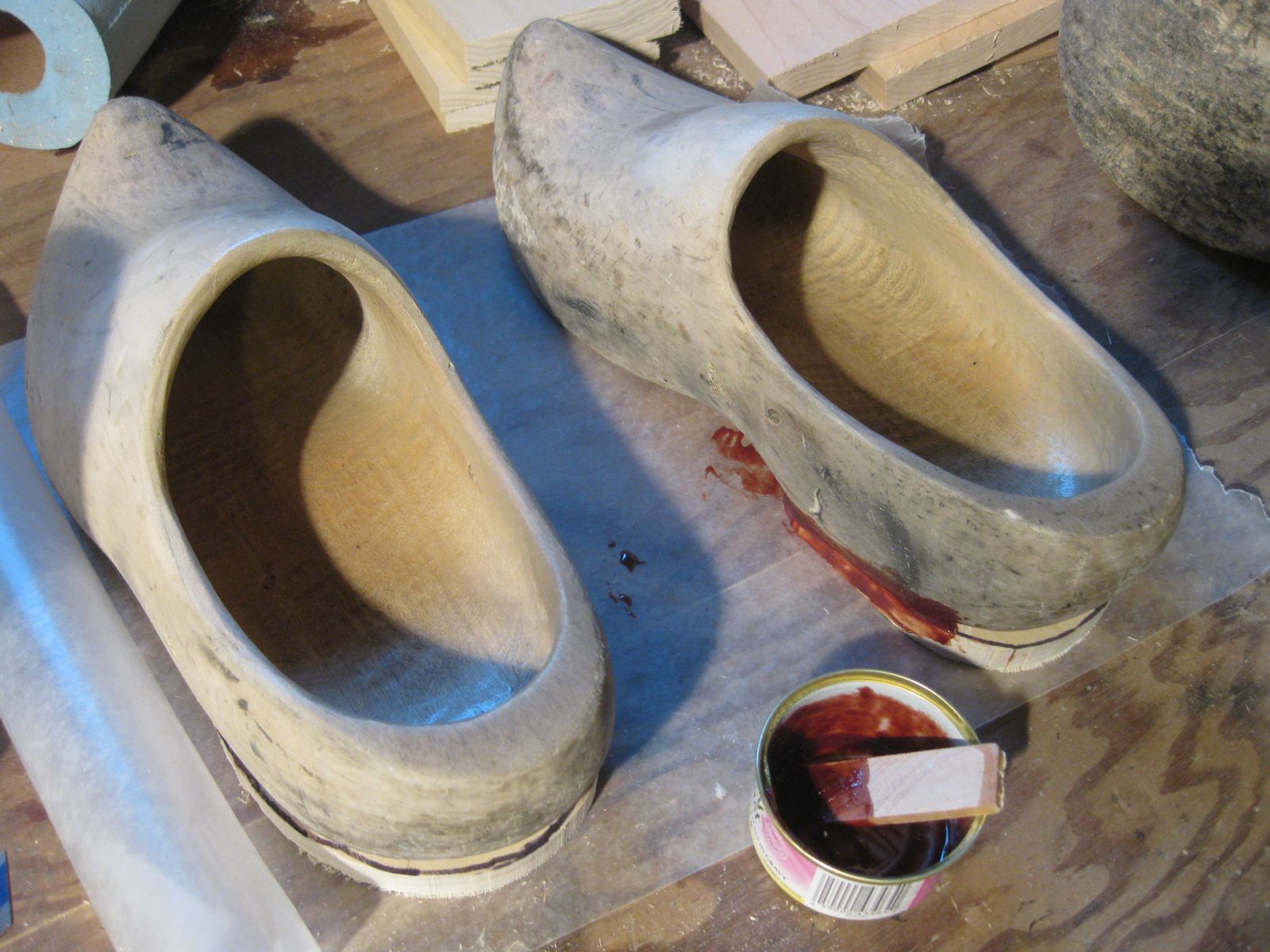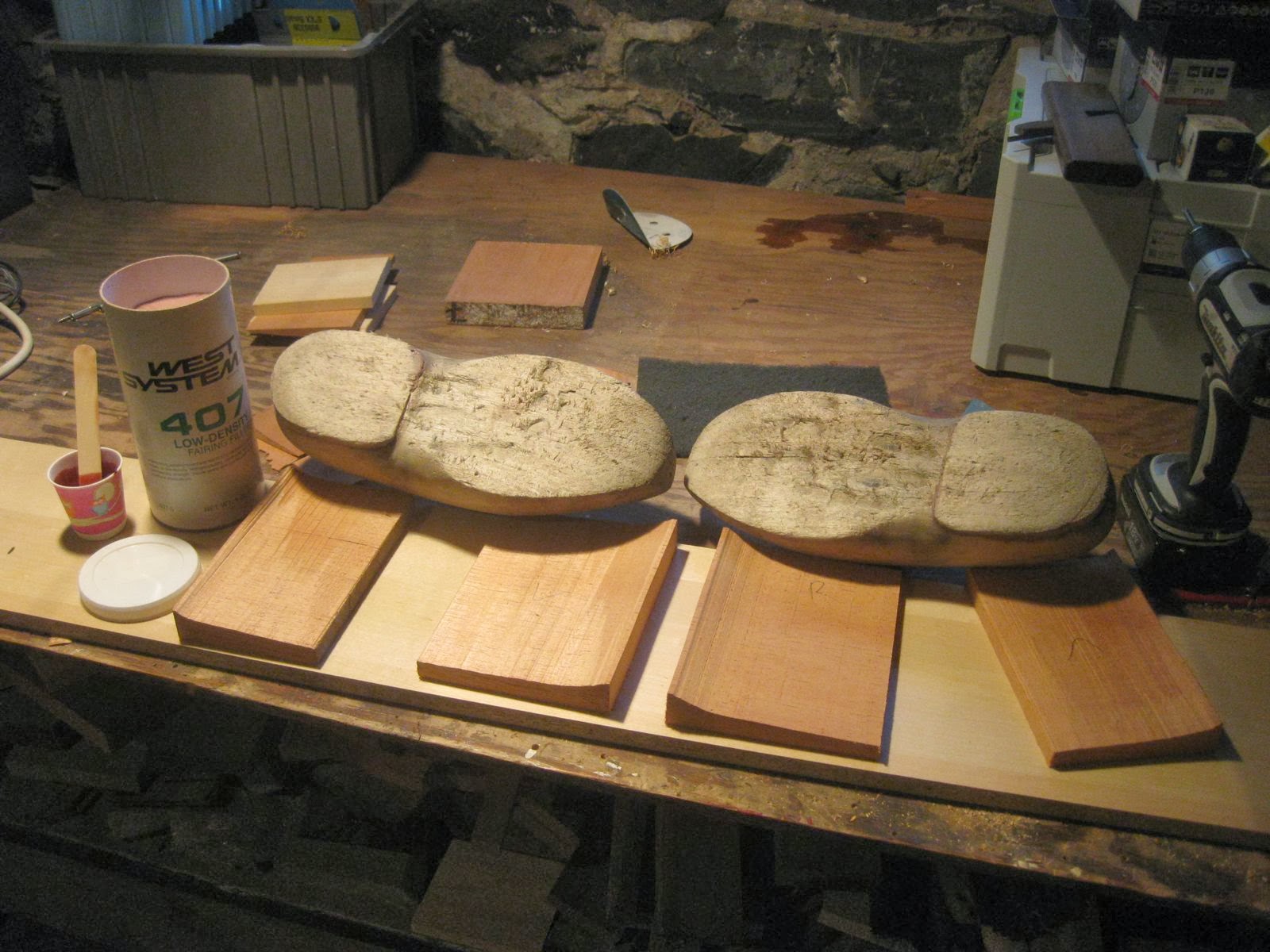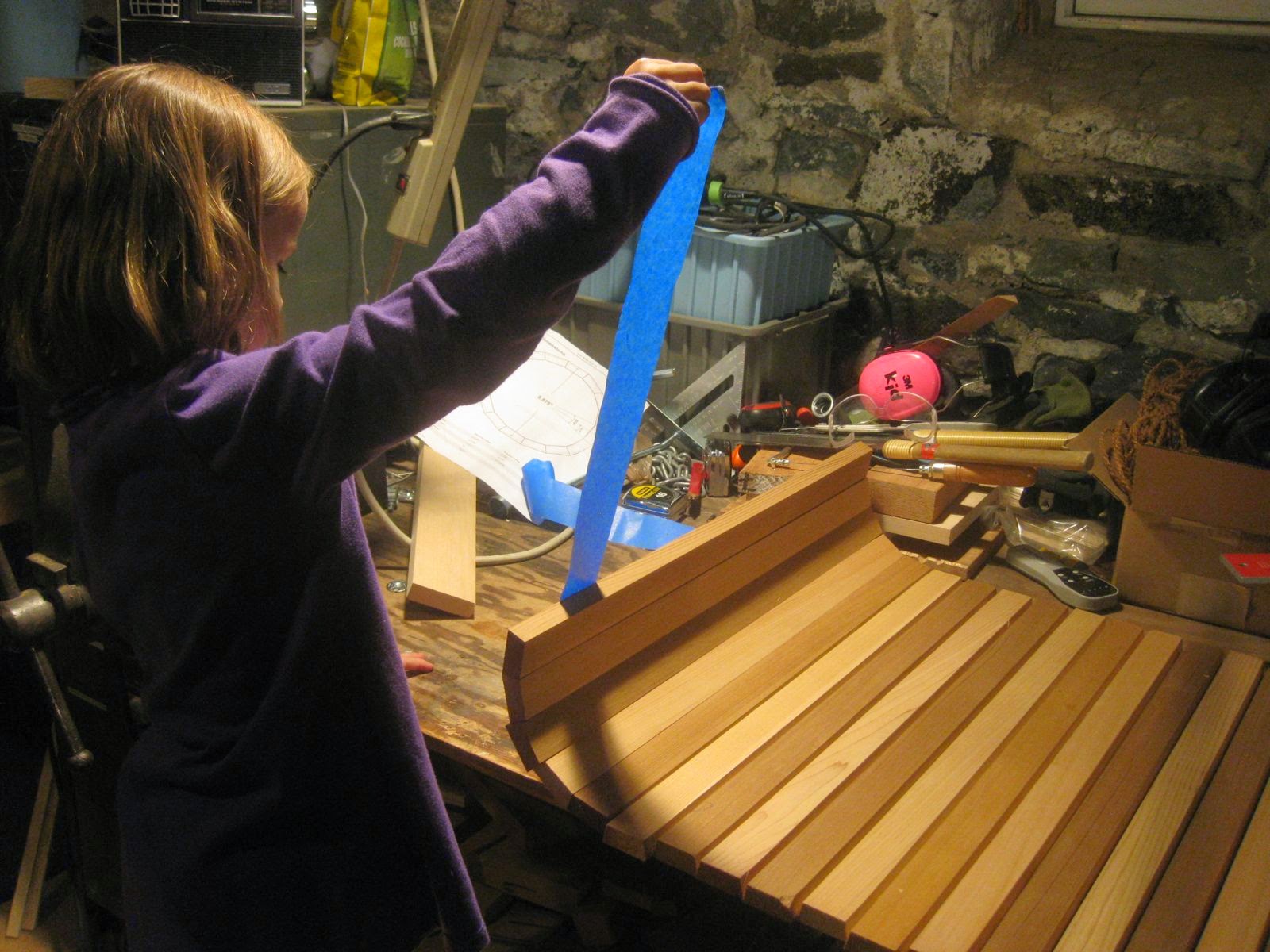The virtues of wood shoes are manifold
- 100% renewable, biodegradable materials
- Durable, long lasting, and can be renovated
- Impact, pierce, and crush resistant
- Heat, cold, and chemical resistant
- Waterproof
- Luxurious comfort, at least for standing on hard surfaces and light walking
- Meet CE standards for safety shoes
- Fashionable, even dare I say cute?
I've been wearing wood shoes part time for about 8 years now. I'm surprised they are not more popular! I've got a total of three pairs, and given that I can work on them myself, I anticipate I'll be able to keep them going for a long time. One pair is a tight fit, for thin socks and summer wear. Below is me with my first daughter at the park for lunch, 7 years ago.
Another is a loose fit, to accommodate two pairs of wool socks for winter bike commuting (as seen in main picture at the top, with gaiters).
The third I usually leave at the bottom of the basement stairs to use as cellar slippers. Child 1 asked me to get her a red pair which I was happy to supply.
Many people including me feel terrible after spending any time standing on concrete. My job, while not as on your feet as a hospital job, still involves many hours spent standing in the lab, which is concrete topped with vinyl composition tile. Standing on concrete in wood shoes is way more comfortable than standing in regular shoes. I've also worn them to work trade shows, which are hell on my feet and back with normal shoes.
They do take some getting used to; heavy wool socks are helpful. The various wood shoes I have bought have not been ready to wear as purchased. Since the vast majority of wood shoes sold these days are sold as tourist trinkets rather than functional footwear, a few tweaks are helpful prior to trying to wear them. In particular, there is a sharp transition around the inner edge of the foot hole that ought to be eased, especially where it curves over the arch. This can be accomplished quickly with a rasp
and some sandpaper.
Once this is done, the process of breaking in your feet can begin.
The shoes actually do break in a little bit, in that the bottoms become softer after repeated exposure to water and walking. The edges of the bottoms also wear as you walk in them to make taking steps more comfortable. But I think the main thing that needs to happen is for the nerves in certain parts of your feet to become less sensitive. After about a year of wearing the clogs at least once a week, they are actually quite comfortable.
If you want to get a lot of baffled looks, try wearing wood shoes while traveling through airports. They have a nice loud clack on the hard floors which draws plenty of attention from any people who are around, who are rewarded for their curiosity by seeing something unusual and puzzling. Sometimes when we are out together Becky thinks people are checking her out, and that she must look extra good that day. But then she is irked to find they are actually just checking out my shoes!
I got my first pair of wood shoes in Holland just before my eldest daughter was born. We were visiting my good friend JD and his wife, who were living in Amsterdam for a year, and we had a wonderful trip. One day we took the train out to see a living history style Dutch village, Zans Schans. Here are JD and Anne on our day trip:
An attraction I definitely wanted to see there was the Klompenmakerij.
They had a set of fascinating machines from the 1920s or 30s for making wood shoes. The wood starts out green, which makes it very easy to work though I imagine some shoes are lost to cracking during later drying. These days most wood shoes seem to be made from poplar, but I read that willow used to be preferred. A typical medium diameter log might get split into quarters to make 4 shoes per length of trunk.
The first machine was a pattern copying lathe. A shoe to be copied was mounted between centers, while the green wood blank is mounted between another set of adjacent centers. The pattern and blank are revolved synchronously at a sedate pace while a pantograph like arrangement rides the surface of the pattern while moving a circular saw like cutter in an analogous fashion over the blank. In this way, most of the exterior of the shoe is formed.
The second machine is an internal pattern copy mortiser type arrangement. The blank and the pattern are locked in place and a pantograph controlled cutter is used to first cut the heel pocket, then repositioned to reach up into the mid and toe sections.
The leftover centers extending from the shoe are chopped off and it is allowed to dry. Then the outside is sanded down. When I was watching the wood shoe making demo in Zans Schans, I started thinking it would be neat to wear these shoes. So after thinking about that, I purchased a pair in Amsterdam.
My two other pairs have been bought on the internets, from DutchVillage.com.
I bet 99.9% wood shoes made are for tourists to buy and take home to use for planters, bird houses, decorations, and other uses besides shoes. But there are a few people who actually wear them. I saw a worker at a construction site in Amsterdam wearing wood shoes. I talked to him about it, and he was the one who clued me in to their ability to meet the criteria for safety shoes in the EU. Also the guy working the demo at the wood shoe workshop. And on occasion, an elderly dutch mechanical engineer at my job.
I really want to get around to making some uppers for one of my pairs, like the boots shown above (photo taken from the Klompenmakerij). This would be great for winter, and would keep snow out better than the gaiters I think.
One other resource for those interested in wood shoes is this book:
I had to buy it, since for some reason they didn't have it in the library.
Renovation
We've all been there, right?. Your favorite pair of wood clogs is worn flat in the heel and canting to the side.
Or maybe the bottoms are worn clean through.
Luckily wood shoes, in addition to being completely renewable, durable, compostable, and fashion forward are pretty simple to work on with basic woodworking tools.
My experience is that the heels wear out first. I've reheeled a few times, in the following photos I used some 12mm thick poplar leftover window stop molding.
The main complicating factor in an otherwise simple operation is that in my case at least the heels don't wear evenly.
So the question is how to fill the gap between the new bottom piece and the remainder of the shoe body. Typically I first epoxy on the bottom, then go back and fill in with wood wedges and more epoxy. Finally, sand around to contour and clean things up.
First, clean up the shoe to receive the new piece. I wire brushed and sanded, then used a rough bench plane.
Cutting out the new pieces.
Ready to epoxy.
Sticking them on and filling the gaps from the sides.
Ready for final sanding.
After a reheeling and a lot more wear, this same set of wood shoes wore all the way through in the front section on the bottom. By this time, they needed new heels again too. I used some scraps of spanish cedar to build them up again.
Below is a look into the right shoe; notice the light coming through the crack in front and the bottom.
Front and back additions for both shoes.
First some cleaning up though.
Trimming the extra off the bottom pieces, after the glue has set.
Epoxy on some toe pieces and wedges for the big gaps between shoe and bottom additions.
The Waterlox on the right was not put on the shoes; it was used on the drum that was going on at the same time.
After final trimming and sanding.
You can see the remnants of previous reheeling operations above the spanish cedar pieces.
Ready to go another round. Second pair that needs new heels shown on the right.
I should also mention that level 0 of wood shoe renovation is just sanding it down, which is akin to shining the shoes. They do tend to get dirty and marked up. Maybe less so if they are finished rather than raw wood. But 10 minutes with a palm sander and they look great again.












































































.JPG)